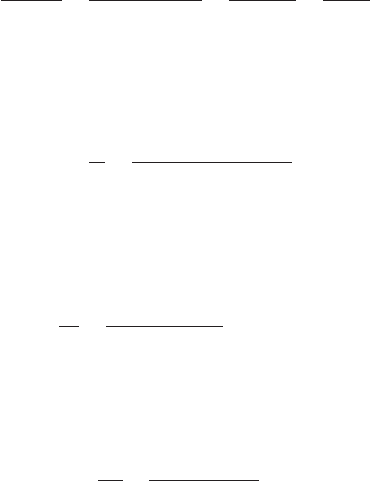Lin S.D. Water and Wastewater Calculations Manual
Подождите немного. Документ загружается.


Sedimentation is a solid—liquid separation by gravitational settling.
There are four types of sedimentation: discrete particle settling (type 1),
flocculant settling (type 2), hindered settling (type 3), and compression
settling (type 4). Sedimentation theories for the four types are discussed
in Chapter 6 and elsewhere (Gregory and Zabel, 1990).
The terminal settling velocity of a single discrete particle is
derived from the forces (gravitational force, buoyant force, and drag
force) that act on the particle. The classical discrete particle set-
tling theories have been based on spherical particles. The equation
is expressed as
(5.60)
where u ⫽ settling velocity of particles, m/s or ft/s
g ⫽ gravitational acceleration, m/s
2
or ft/s
2
r
p
⫽ density of particles, kg/m
3
or lb/ft
3
r ⫽ density of water, kg/m
3
or lb/ft
3
d ⫽ diameter of particles, m or ft
C
D
⫽ coefficient of drag
The values of drag coefficient depend on the density of water (), rel-
ative velocity ( µ), particle diameter (d), and viscosity of water (µ), which
gives the Reynolds number R as:
(5.61)
The value of C
D
decreases as the Reynolds number increases. For R
less than 2 (or 1), C
D
is related to R by the linear expression as follows:
(5.62)
At low values of R, substituting Eq. (5.61) and (5.62) into Eq. (5.60)
gives
(5.63)
This expression is known as the Stokes’ equation for laminar flow
conditions.
u 5
gsr
p
2 rdd
2
18 m
C
D
5
24
R
R 5
rud
m
u 5 a
4gsr
p
2 rdd
3C
Dr
b
1/2
Public Water Supply 385

In the region of higher Reynolds numbers (2 < R < 500⫺1000), C
D
becomes (Fair et al., 1968):
(5.64)
In the region of turbulent flow (500⫺1000 < R < 200,000,) the C
D
remains approximately constant at 0.44. The velocity of settling parti-
cles results in Newton’s equation (ASCE and AWWA 1990):
(5.65)
When the Reynolds number is greater than 200,000, the drag force
decreases substantially and C
D
becomes 0.10. No settling occurs at this
condition.
Example: Estimate the terminal settling velocity in water at a temperature
of 15°C of spherical silicon particles with specific gravity 2.40 and average
diameter of (a) 0.05 mm and (b) 1.0 mm.
solution:
Step 1. Using the Stokes’ equation (Eq. (5.63)) for (a)
From Table 4.1a, at T ⫽ 15°C
⫽ 999 kg/m
3
, and m ⫽ 0.00113 N ⋅ s/m
2
d ⫽ 0.05 mm ⫽ 5 ⫻ 10
⫺5
m
(a)
Step 2. Check with the Reynolds number (Eq. (5.61))
(a) The Stokes’ law applies, since R < 2.
5 0.075
R 5
rud
m
5
999 3 0.00169 3 5 3 10
25
0.00113
5 0.00169 m/s
5
9.81 m/s
2
s2400 2 999d kg/m
3
s5 3 10
25
md
2
18 3 0.00113 N
#
s/m
2
u 5
gsr
p
2 rdd
2
18 m
u 5 1.74 c
sr
p
2 rdgd
r
d
1/2
C
D
5
24
R
1
3
!R
1 0.34
386 Chapter 5

Step 3. Using the Stokes’ law for (b), d ⫽ 1 mm ⫽ 0.001 m
Step 4. Check the Reynold number
Assume the irregularities of the particles ⫽ 0.85
Since R > 2, the Stokes’ law does not apply. Use Eq. (5.60) to calculate u.
Step 5. Using Eqs. (5.64) and (5.60)
Step 6. Recheck R
Step 7. Repeat Step 5 with new R
u 5 0.155 sm/sd
u
2
5
4 3 9.81 3 1401 3 0.001
3 3 0.76 3 999
5 0.76
C
D
5
24
141
1
3
!141
1 0.34
5 141
R 5
frud
m
5
0.85 3 999 3 0.188 3 0.001
0.00113
u 5 0.188 sm/sd
u
2
5
4 3 9.81 3 s2400 2 999d 3 0.001
3 3 0.52 3 999
u
2
5
4gsr
p
2 rdd
3C
D
r
5 0.52
C
D
5
24
R
1
3
!R
1 0.34 5
24
508
1
3
!508
1 0.34
5 508
R 5
frud
m
5
0.85 3 999 3 0.676 3 0.001
0.00113
f
5 0.676 sm/sd
u 5
9.81s2400 2 999ds0.001d
2
18 3 0.00113
Public Water Supply 387

Step 8. Recheck R
Step 9. Repeat Step 7
(b) The estimated velocity is around 0.15 m/s, based on Steps 7 and 9.
10.1 Overflow rate
For sizing the sedimentation basin, the traditional criteria used are
based on overflow rate, detention time, weir loading rate, and horizon-
tal velocity. The theoretical detention time is computed from the volume
of the basin divided by average daily flow (plug flow theory):
(5.66)
where t ⫽ detention time, h
24 ⫽ 24 h/d
V ⫽ volume of basin, m
3
or million gallon (Mgal)
Q ⫽ average daily flow, m
3
/d or Mgal/d (MGD)
The overflow rate is a standard design parameter which can be deter-
mined from discrete particle settling analysis. The overflow rate or sur-
face loading rate is calculated by dividing the average daily flow by the
total area of the sedimentation basin as follows:
(5.67)
where u ⫽ overflow rate, m
3
/(m
2
⋅ d) or gpd/ft
2
Q ⫽ average daily flow, m
3
/d or gpd
A ⫽ total surface area of basin, m
2
or ft
2
l and w ⫽ length and width of basin, respectively m or ft
u 5
Q
A
5
Q
lw
t 5
24V
Q
u 5 0.149 sm/sd
u
2
5
4 3 9.81 3 1401 3 0.001
3 3 0.83 3 999
5 0.83
C
D
5
24
116
1
3
!116
1 0.34
5 116
R 5
0.85 3 999 3 0.155 3 0.001
0.00113
388 Chapter 5

For alum coagulation, u is usually in the range of 40 to 60 m
3
/(m
2
⋅ d)
(or m/d) (980 to 1470 gpd/ft
2
) for turbidity and color removal. For lime
softening, the overflow rate ranges 50 to 110 m/d (1230 to 2700
gpm/ft
2
). The overflow rate in wastewater treatment is lower, rang-
ing from 10 to 60 m/d (245 to 1470 gpm/ft
2
). All particles having a set-
tling velocity greater than the overflow rate will settle and be removed.
It should be noted that rapid particle density changes due to tem-
perature, solid concentration, or salinity can induce density current
which can cause severe short-circuiting in horizontal tanks (Hudson,
1972).
Example: A water treatment plant has four clarifiers treating 4.0 MGD
(0.175 m
3
/s) of water. Each clarifier is 16 ft (4.88 m) wide, 80 ft (24.4 m) long,
and 15 ft (4.57 m) deep. Determine: (a) the detention time, (b) overflow rate,
(c) horizontal velocity, and (d) weir loading rate assuming the weir length is
2.5 times the basin width.
solution:
Step 1. Compute detention time t for each clarifier, using Eq. (5.66)
(a)
Step 2. Compute overflow rate u, using Eq. (5.67)
(b)
Step 3. Compute horizontal velocity v
(c)
5 0.387 ft/min 5 11.8 cm/min
v 5
Q
wd
5
92.83 ft
3
/min
16 ft 3 15 ft
5 781 gpd/ft
2
5 31.83 m
3
/m
2
#
d
u 5
Q
lw
5
1,000,000 gpd
16 ft 3 80 ft
5 3.447 h
t 5
V
Q
5
16 ft 3 80 ft 3 15 ft
5570 ft
3
/h
5 92.83 ft
3
/min
5 5570 ft
3
/h
Q 5
4 MGD
4
5
1,000,000 gal
d
3
1 ft
3
7.48 gal
3
1 day
24 h
Public Water Supply 389

Step 4. Compute weir loading rate u
w
(d)
10.2 Inclined settlers
Inclined (tube and plate) settlers are sedimentation units that have
been used for more than two decades. A large number of smaller diam-
eter (20 to 50 mm) tubes are nested together to act as a single unit and
inclined with various angles (7⬚ to 60⬚). The typical separation distance
between inclined plates for unhindered settling is 2 in (5 cm) with
inclines of 3 to 6 ft (1 to 2 m) height. The solids or flocs settle by gravi-
tational force. It is not necessary to use tubes and can take various
forms or plates also. The materials are lightweight, generally PVC or
ABC plastic (1 m ⫻ 3 m in size).
Tube settlers have proved as effective units. However, there is a ten-
dency of clogging.
Inclined settling systems can be designed as cocurrent, countercur-
rent, and cross-flow. Comprehensive theoretical analyses of various flow
geometries have been discussed by Yao (1976). The flow velocity of the
settler module (v) and the surface loading rate for the inclined settler
(u) (Fig. 5.6) are calculated as (James M. Montgomery Consulting
Engineering, 1985):
(5.68)
(5.69)
where v ⫽ velocity of the water in settlers, m/s or ft/s
Q ⫽ flow rate, m
3
/s or MGD
A ⫽ surface area of basin, m
2
or ft
2
⫽ inclined angle of the settlers
u ⫽ settling velocity, m/s or ft/s
w ⫽ width of settler, m or ft
H ⫽ vertical height, m or ft.
Example: Two flocculators treat 1.0 m
3
/s (22.8 MGD) and remove flocs large
than 0.02 mm. The settling velocity of the 0.02 mm flocs is measured in the
laboratory as 0.22 mm/s (0.67 in/min) at 15°C. Tube settlers of 50.8 mm (2
in) square honeycombs are inclined at a 50° angle, and its vertical height is
u 5
Qw
AsH cos u 1 w cos
2
ud
v 5
Q
A sin u
5 25,000 gpd/ft 5 310 m
3
/m
#
d
u
w
5
Q
2.5w
5
1,000,000 gpd
2.5 3 16 ft
390 Chapter 5

1.22 m (4 ft). Determine the basin area required for the settler module and
the size of each flocculator at 15°C.
solution:
Step 1. Determine the area needed for the settler modules
Q ⫽ (1 m
3
/s)/2 ⫽ 0.5 m
3
/s ⫽ 30 m
3
/min
w ⫽ 50.8 mm ⫽ 0.0508 m
H ⫽ 1.22 m
⫽ 50°
Using Eq. (5.69)
Step 2. Determine A
In practice, the actual conditions in the settlers are not as good as under con-
trolled laboratory ideal conditions.
A safety factor of 0.6 may be applied to determine the designed settling
velocity. Thus
suse 240 m
2
d
A 5 238.6 m
2
u 5 0.6 3 0.00022 m/s 5
0.0315
A
5
0.0315
A
5
0.5s0.0508d
As1.22 3 0.643 1 0.0508 3 0.643
2
d
u 5
Qw
AsH cos u 1 w cos
2
ud
Public Water Supply 391
v
H
u
w
Figure 5.6 Schematic diagram of settling section.

Step 3. Find surface loading rate Q/A
Q/A ⫽ (0.5 ⫻ 24 ⫻ 60 ⫻ 60 m
3
/d)/240 m
2
⫽ 180 m
3
/(m
2
⋅ d)
⫽ 3.07 gpm/ft
2
(Note: 1m
3
/(m
2
⋅ d) ⫽ 0.017 gpm/ft
2
Step 4. Compute flow velocity in the settlers, using Eq. (5.68)
v ⫽ Q/A sin ⫽ 180/0.766
⫽ 235 (m/d)
⫽ 0.163 m/min
⫽0.0027 m/s
Step 5. Determine size of the basin
Two identical settling basins are designed. Generally, the water depth of the
basin is 4 m (13.1 ft). The width of the basin is chosen as 8.0 m (26.2 ft). The
calculated length of the basin covered by the settler is
l ⫽ 240 m
2
/8 m ⫽ 30 m ⫽ 98 ft
In practice, one-fourth of the basin length is left as a reserved volume for
future expansion. The total length of the basin should be
Step 6. Check horizontal velocity
Q/A ⫽ (30 m
3
/min)/(4 m ⫻ 8 m)
⫽ 0.938 m/min ⫽ 3 ft/min
Step 7. Check Reynolds number (R) in the settler module
11 Filtration
The conventional filtration process is probably the most important
single unit operation of all the water treatment processes. It is an oper-
ation process to separate suspended matter from water by flowing it
5 30 , 2000, thus it is in a lamella flow
R 5
vR
m
5
s0.0027 m/sds0.0127 md
0.000001131 m
2
/s
Hydraulic radius R 5
0.0508
2
4 3 0.0508
5 0.0127 m
30 m 3
4
3
5 40 ms131 ftd
392 Chapter 5

through porous filter medium or media. The filter media may be silica
sand, anthracite coal, diatomaceous earth, garnet, ilmenite, or finely
woven fabric.
In early times, a slow sand filter was used. It is still proved to be
efficient. It is very effective for removing flocs containing microor-
ganisms such as algae, bacteria, virus, Giardia, and Cryptosporidium.
Rapid filtration has been very popular for several decades. Filtration
usually follows the coagulation–flocculation–sedimentation processes.
However, for some water treatment, direct filtration is used due to the
high quality of raw water. Dual-media filters (sand and anthracite,
activated carbon, or granite) give more benefits than single-media fil-
ters and became more popular; even triple-media filters have been
used. In Russia, up-flow filters are used. All filters need to clean out
the medium by backwash after a certain period (most are based on
head loss) of filtration.
The filters are also classified by allowing loading rate. Loading rate
is the flow rate of water applied to the unit area of the filter. It is the
same value as the flow velocity approaching the filter surface and can
be determined by
v ⫽ Q/A (5.67a)
where v ⫽ loading rate, m
3
/(m
2
⋅ d) or gpm/ft
2
Q ⫽ flow rate, m
3
/d or ft
3
/d or gpm
A ⫽ surface area of filter, m
2
or ft
2
On the basis of loading rate, the filters are classified as slow sand fil-
ters, rapid sand filters, and high-rate sand filters. With each type of filter
medium or media, there are typical design criteria for the range of load-
ing rate, effective size, uniform coefficient, minimum depth require-
ments, and backwash rate. The typical loading rate for rapid sand filters
is 120 m
3
/(m
2
⋅ d) [83 L/(m
2
⋅ min) or 2 gpm/ft
2
]. For high-rate filters, the
loading rate may be four to five times this rate.
Example: A city is to install rapid sand filters downstream of the clarifiers.
The design loading rate is selected to be 160 m
3
/(m
2
⋅ d) (2.7 gpm/ft
2
). The
design capacity of the waterworks is 0.35 m
3
/s (8 MGD). The maximum sur-
face per filter is limited to 50 m
2
. Design the number and size of filters and cal-
culate the normal filtration rate.
solution:
Step 1. Determine the total surface area required
A 5
Q
v
5
0.35 m
3
/s s86,400 s/dd
160 m
3
/m
2
#
d
5 189 m
2
Public Water Supply 393

Step 2. Determine the number (n) of filters
Select four filters.
The surface area (a) for each filter is
a ⫽ 189 m
2
/4 ⫽ 47.25 m
2
We can use 7 m ⫻ 7 m or 6 m ⫻ 8 m, or 5.9 m ⫻ 8 m (exact)
Step 3. If a 7 m ⫻ 7 m filter is installed, the normal filtration rate is
11.1 Filter medium size
Before a filter medium is selected, a grain size distribution analysis
should be performed. The sieve size and percentage passing by weight
relationships are plotted on logarithmic-probability paper. A straight
line can be drawn. Determine the geometric mean size (m
g
) and geo-
metric standard deviation size (
g
). The most common parameters
used in the United States to characterize the filter medium are effec-
tive size (ES) and uniformity coefficient (UC) of medium size distri-
bution. The ES is that the grain size for which 10% of the grain (d
10
)
are smaller by weight. The UC is the ratio of the 60-percentile (d
60
)
to the 10-percentile. They can be written as (Fair et al., 1968; Cleasby,
1990):
(5.70)
(5.71)
The 90-percentile, d
90
, is the size for which 90% of the grains are smaller
by weight. It is interrelated to d
10
as (Cleasby 1990)
d
90
⫽ d
10
(10
1.67 log UC
) (5.72)
The d
90
size is used for computing the required filter backwash rate for
a filter medium.
Example: A sieve analysis curve of a typical filter sand gives d
10
⫽ 0.54 mm
and d
60
⫽ 0.74 mm. What are its uniformity coefficient and d
90
?
UC 5 d
60
/d
10
5 s
1.535
g
ES 5 d
10
5 m
g
/s
1.282
g
v 5
Q
A
5
0.35 m
3
/s 3 86,400 s/d
4 3 7 m 3 7 m
5 154.3 m
3
/sm
2
#
dd
n 5
189 m
2
50 m
5 3.78
394 Chapter 5
